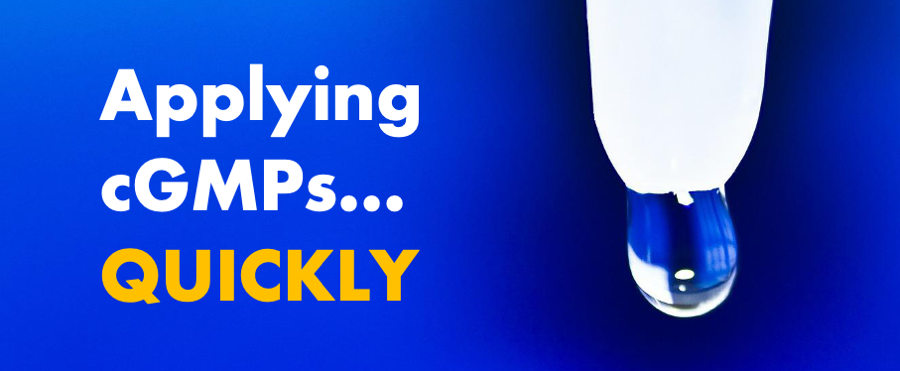Combination Product Industry News & Guidance
Sharing device-related information and wisdom
that will help you succeed
Quick Changes Needed: Applying cGMPs for Combination Products to Ophthalmic Devices

If your company currently markets or is developing a drug with an ophthalmic dispenser (eye cups, eye droppers, and other dispensers intended for ophthalmic use), it is likely you have seen the FDA Guidance issued on Mar 22, 2022 whereby such products will now be treated as combination products (rather than drugs only). This was driven by a legal interpretation of the definition of drugs and devices in Genus litigation, which is further described on the FDA Office of Combination Products’ website. The result: Combination Product cGMPs will now newly apply to your products, both existing and future.
What do you need to do?
UNDERSTAND THE SPECIFICS:
Combination Product cGMPs are defined in regulation (21 CFR 4 Subpart A) and accompanying guidance, which apply to a wide variety of combination products and are inherently generalized for such usage. While many companies have performed “DHF Remediation” (demonstrated compliance to Design Controls as a part of Combination Product cGMPs) for marketed combination products and/or developed new combination products accounting for these cGMPs, the specifics in each situation necessarily differ, and application to ophthalmic delivery devices presents new and unique challenges. The combination product regulations add specific elements from medical devices beyond the drug cGMPs, particularly Design Controls, which can be a challenge for companies who have limited or no personnel experienced with these parts of the device cGMPs. Additionally, such companies may not have relevant procedures in their Quality Management System to handle combination products. Furter complicating things, the Quality Assurance group may not be experienced in such requirements, likely having focused on a drug-based QMS.
PLAN FOR TIGHT TIMELINES:
The FDA has provided a relatively short 12-month compliance period, however with essentially no notice (since this was announced in a direct-to-final guidance). This time period will pose resource challenges to companies with such products; even those companies equipped with experienced staff, as this directive comes at a time when many companies are facing resource limitations due to urgent product development needs and a competitive labor market. Additionally, it’s worth noting that the original Combination Product cGMP rule was promulgated in Jan 2013 and had a 6-month compliance period; the first significant warning letter was issued against these regulations just 12 months later (Jan 2014), which was borne from an inspection conducted prior to that date. So, it is fair to assume FDA is likely interested in enforcing this for relevant products immediately after the compliance date (Mar 2023). This historic clamping down, in combination with a sharp increase in inspection activity following the lifting of pandemic-related travel restrictions, may very well lead to targeted enforcement action by FDA and likely little to no wiggle room for you past the deadline.
If you need support…
Shortage of experience in treating these ophthalmic delivery devices as combination products, constrained resources, and a short timeline for compliance pose challenges for many organizations. One solution to overcome these challenges is to outsource some or all of the work to specialists on the subject. Your company can leverage Suttons Creek’s expertise to ensure ‘inspection readiness’ (for marketed products) or ‘submission readiness’ (for products in development) on-time without stretching existing resources, particularly with what may be unfamiliar requirements for a typical drug team. Suttons Creek also assists larger companies with embedded device/combination product development teams, particularly when they need supplemental assistance in cases just like this!
We have led DHF Remediation efforts for Combination Product cGMP compliance at a number of companies (ranging from large to small) and for a variety of products (with a range of routes of administration, marketed products, and products in development). Some key components of such remediation where Suttons Creek has expertise includes: Quality Management System (QMS) compliance with 21 CFR 4, Design & Development Planning, Design Inputs and Outputs, Verification and Validation, Design Transfer, and compiling all of the relevant documentation into a usable (and inspectable) Design History File (DHF). We have vast experience leveraging existing data from the drug development process and information from device and/or component suppliers to complete such activities, supplementing with new documentation when needed. Additionally, Suttons Creek has the cross-functional device expertise (Engineering, Quality, and Regulatory) to create such a file while integrating disciplines such as Risk Management and Human Factors/Usability Engineering.
If you need assistance on this topic, please reach out to Suttons Creek and have a consultation with our team to assess your needs and craft a tailored solution. Our consulting structure is flexible and agile, with a teaming system that provides remediation services in a highly cost-effective and time sensitive manner. We are more than happy to continue helping clients reach compliance in the evolving world of devices and combination products!
Jonathan Amaya-Hodges, Senior Principal Consultant, Regulatory & Quality, Suttons Creek, Inc. – Jonathan has over 16 years of multidisciplinary experience in regulated medical products (drugs, biologics, medical devices, and combination products) at multiple global companies. He has practical experience in Development/Engineering, Quality Assurance, and Regulatory Affairs for various types of combination products with a focus on drug delivery. Additional background includes digital health (including smart packaging/connected devices and software as a medical device, or SaMD) and in vitro diagnostics, along with clinical development (bridging) and lifecycle management for combination products. Jonathan engages with the global combination product community by speaking at conferences, lecturing in courses, serving key roles within prominent industry organizations, and interfacing with regulators on a variety of topics.
